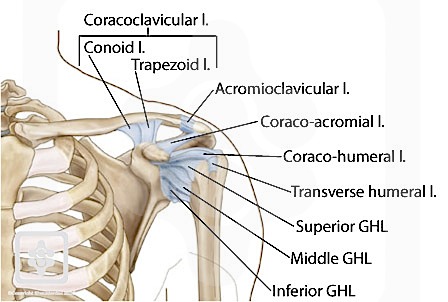Shoulder Ligaments
Ligaments are soft tissue structures that connect bones to bones. There are several important ligaments in the shoulder.
Glenohumeral Ligaments (GHL):
A joint capsule is a watertight sac that surrounds a joint. In the shoulder, the joint capsule is formed by a group of ligaments that connect the humerus to the glenoid. These ligaments are the main source of stability for the shoulder. They are the superior, middle and inferior glenohumeral ligaments. They help hold the shoulder in place and keep it from dislocating .
Coraco-acromial Ligament (CAL):
Another ligament links the coracoid to the acromion - coracoacromial ligament (CAL). This ligament can thicken and cause Impingement Syndrome
Coraco-clavicular Ligaments (CCL):
These two ligaments (trapezoid and conoid ligaments) attach the clavicle coracoid process of the scapula. These tiny ligaments (with the acomioclavicular joint) play an important role in keeping the scapula attached to the clavicle and thus keeping your shoulder 'square'. They carry a massive load and are extremely strong.
A fall on the point of the shoulder can rupture these ligaments with dislocation of the AC Joint .
Transverse Humeral Ligament (THL) :Holds the tendon of the long head of biceps brachii muscle in the groove between the greater and lesser tubercle on the humerus (intertubercular sulcus).



